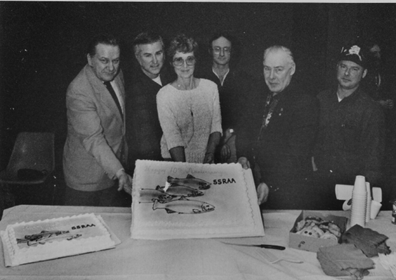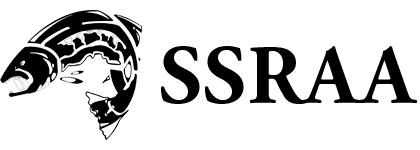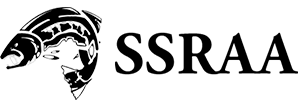
The following speech by Patricia Roppel was given in commemoration of SSRAA’s first ten years. Pat is a historian and author who wrote, among other things, a history of the first hatcheries in Alaska; “Alaska’s Salmon Hatcheries, 1891 – 1959” (Alaska University Press).
Pat recently sent us the notes from which she spoke. We have done our best to reproduce the talk, and apologies to Pat for any mistakes we might have made in the process. She now resides in Sitka.
“Even though I am an historian and have researched and written a number of things, including a book on the pre-statehood hatcheries, it never occurred to me in the 10 years that I have been with SSRAA that one day someone would ask me to tell the history of this organization.
The early years were so emotional – and we were so intense in our fight for existence that things like dates didn’t stick in my memory – we lived from crisis to crisis – each one, it seemed more monumental than the last one. At least, I had sense enough to keep all the papers that we members of the Board of directors received, and when we moved to Sitka a couple of years ago, I donated them to the museum where they take up an astonishing amount of shelf space.
How did we get started? And how did I, a non-fisherman, get involved. This all started in 1976, two years after a non-profit aquaculture bill passed the legislature and was signed into law in 1974. That first law was VERY ambiguous – it had been lobbied by the fishermen to prevent ocean ranching – in other words Weyerhouser and Domsea at Manchester – from coming to Alaska. In essence the law said, only non-profit organizations could build hatcheries and raise salmon. It did not define “non-profit organizations”.
The seiner, gillnetter and troll associations in Ketchikan began separately to consider the potentials for salmon hatcheries. At that time there was a FRED Hatchery at Beaver Falls which had produced no returning fish, and the one in Petersburg (Crystal Lake) which had been in operation for about 4 years and had no visible success. Fishermen felt they could do better than that without all the red tape.
Three men volunteered the time to try and put something together for the fishermen to operate under the new ambiguous law. They were Dick Bishop, a gillnetter, Larry Painter, a seiner, and Jon Rowley, a troller, and it was really Jon’ s enthusiasm that got a group of fishermen together at the seiners association’s office on Water Street. He advertised in the newspaper that there would be a meeting of interested people and since I had been doing research on early hatcheries, I went to see what was going on.
There proved to be enough interest that it was decided we should open an office half days in the Seiner’s office, and I would man (woman) the office starting April 5, 1976. Our biggest concern was finding some money to be able to raise money. It was really a $5,000 donation from the King Salmon Derby of the Ketchikan Chamber of Commerce which made it possible to start functioning. We had John Sund draw up an articles of incorporation and the by-laws and on May 24, 1976, Southern Southeast Regional Aquaculture Association (SSRAA) was formally incorporated as a private non-profit corporation under the Alaskan laws. The ten original incorporators were: Jake Jacobson, Jim Bray, Maurie Ingman, Roger Ingman, Joe Demmert, Larry Painter, Dick Bishop, Larry Dalton, Jon Rowley, and Pat Roppel.
We had the first directors meeting on June 26, 1976 and Larry Dalton was elected president, Larry Painter vice president, Jon Rowley secretary-vice president, and Pat Roppel secretary-treasurer. In November of 1976 the board was increased to include a sports fisherman representative, processors, chamber of commerce, municipality, and three at-large positions for a total of 19 Board positions.
It was assumed that, like the newly incorporated Prince William Sound Aquaculture Association in Cordova, that fishermen would voluntarily assess themselves to pay for the program, that processors would match the assessments, and seed monies would be raised by donations from the Ketchikan community and from the fishermen or by state grants.
We sent out letters to 1,800 permit holders explaining the program and asking for their support. A month later, we sent another letter. 34 fishermen responded and by mid-August $13,000 was raised.
By June Jon, Larry and Dick realized that fishing season was coming, and I knew my children who were in grade school would be home all day and I could no longer donate my time in the office, so we began to search for an executive director. Jon advertised in a number of papers in Seattle, Portland and places like that. One of the people to apply was Jack Milnes. Jack was willing to come to Alaska knowing we didn’t have enough to pay him for more than a month or two. He had a background in creating management systems and raising money to put these systems in effect. He was hired in August of 1976. He lived in Larry Dalton’s boat for a little while and got deathly sea-sick when his bedroom went gillnetting at Tree Point; so we rented an office on the ground floor of the Marine View. Jack didn’t have much privacy in those days. We didn’t have enough chairs and sometimes held executive committee meetings sitting on his bed.
By this time Larry Dalton was the president of SSRAA and he was volunteering nearly full time, trying to get the program off the ground. And, we faced enormous problems. Money was always a problem, and under refinements of the non-profit law made in 1976, we were able to get some seed money from the legislature. Our attempts to get voluntary donations continued to be poor, partly because of the uncertainty around the limited entry law and whether it would remain in effect. If you recall, after being declared constitutional, the issue was brought before the public on November ballot. We waited for this issue to be resolved.
Fish and Game presented one of our biggest obstacles. They saw SSRAA as a threat to their fledgling hatchery program. I will never forget the night we met at the longshoreman’s hall in May of 1976. Stan Moberly (FRED Division Regional Supervisor) dictated to us that we had to expand our region. The law gives no dictate on boundaries, so we had set our northern border as Luck Point – 56 degrees. But Fish and Game had the power to divide the state into the regional corporations, a concept which had been added to the law in 1976. ADF&G decided to divide Southeastern Alaska into two regions and we had to include all of ADF&G’s fishing districts 1 through 8, including Petersburg and Wrangell. We were very upset because the fishermen in Petersburg and Wrangell really didn’t want an aquaculture association. Petersburg had seen the failures at Crystal Lake Hatchery. Our arguments were to no avail, and we changed our boundaries and amended the by-laws in November of 1976. And, it took years to gain the cooperation of the fishermen of these towns.
Then we had to find brood stock from which to take eggs. Fish and Game didn’t help much there either. Larry Dalton, Jim Bray and Dick Bishop coordinated field counts of coho in local streams. Bill Smoker worked for us in 1977 to continue these studies. With funding tight board members donated time, boats, and cash to do the work that staff does today. Dick Bishop and I went out to Shelokem Lake once to look at the hot springs and check the temperature to see if we would utilize the hot water. Larry, Jake, Jim all did this type of research.
In the fall of 1977 we had egg-take crews on several streams where Fish and Game said we could get eggs, if the runs were big enough. One stream was in Walker Cove, the other in Cordova Bay. Our fellows sat out there and watched three of four fish return; no eggs were collected and we lost a year’s production.
We put up the small building at Beaver Falls to incubate the non-existent eggs, the one we now use for our sockeye program and fortunately we were able to put eggs in the building in 1978.
Once limited entry was securely in place, we proposed a mandatory assessment from all fishermen, patterned after some apple growers program Jack knew of. The program passed and the SSRAA Board certified that election June 10, 1977. We finally had money to use as security to build a hatchery. John Sund and Terry Gardiner, who was at that time a legislator, were able to get a loan fund in place in 1977 so non-profit hatcheries could borrow money to build their facilities.
SSRAA’s concept was that we would have a central incubation facility and bring eggs to the hatchery and return the fry to remote locations for release. Planning began in 1977 after we selected Whitman Lake as the site for the hatchery. The sites selected for remote releases were Nakat Bay and Neets Bay, however we listed Kendrick Bay and Anita Bay as alternatives (SSRAA has release sites at all these locations today.) We finally were able to secure, against the seiners and FRED’s wishes, chum eggs (fall chum) from Disappearance Creek.
It was about this time that SSRAA Board members learned the true meaning of Friday the 13th. It was on such a date in 1977 that we learned we were party to a law suit that the 3% salmon enhancement tax was illegal. Fortunately the state stepped in to help us fight this suit. During the time of the suit, this tax was taken out of the fishermen’s gross earnings but not distributed to us. After the tax was declared illegal, many fishermen answered our pleas and donated their tax to us. All of these men received a SSRAA hat in return. So if you ever see anyone with a SSRAA hat, you know that that person really supported us in our hour of need.
With a great deal of lobbying effort, a law was passed which made it possible for the fisherman to be mandatorily taxed 3% by the state, with the funds returned to the associations. In January of 1981 the fishermen again approved the salmon enhancement tax by a 3 to 2 ratio. It’s through this tax we have been able to secure our state loans, using it as collateral.
It was a proud day for us when we dedicated Whitman Lake Hatchery on August 17, 1979. By this time we had a larger staff and had moved from Jack’s bedroom to an office on Creek Street, and then later to Mill Street above Jimbo’s Restaurant, and finally to a house at the old Sunny Point Cannery.
We were doing other things now. Many of the fishermen did not want to see SSRAA involved in building concrete monuments and we began to look at lake fertilization. Dr. Stocker from the Canadian lake fertilization program came to talk to us and told us of the wonders of their Central Lake Program. In August 1979 we began pre-lake fertilization studies on a number of the sockeye systems in our area and it was determined to work with Hugh Smith Lake and eventually McDonald Lake. After we lobbied the legislature for money, actual fertilization began in the spring of 1980.
Part of the revised non-profit hatchery act mandated that fishermen and ADF&G jointly plan for the orderly development of the hatchery program in southeast Alaska. So we hired someone to do our planning, this was Rich Harris, one of our current board members. Phase I of this plan was completed in spring of 1980.
In 1979, Jack felt we needed to have some long range plans of our own, as we hired Leonard Lane Associates to help us develop goals and objectives and we put together a SSRAA Long Range Plan, something the corporation continues to update yearly in October.
Our egg takes continued to increase; our survival rates became better and better. By spring of 1981 we were releasing 19 million fry. Only 4 years earlier we couldn’t find a chum salmon to spawn for eggs. We were now producing coho salmon too and eventually were able to secure king salmon eggs from the Unuk River. Some of our staff had interesting adventures sitting on the banks waiting for the king salmon runs. Sitting there competing with those big brown bears.
We had to expand Whitman Lake and when we got to that fateful number 13, we named the raceway number 14. For a number of years we were so superstitious we never met on Friday the 13th. And one other 13th date produced a disaster for SSRAA, on February 13, 1982, the water system at Whitman Lake malfunctioned after an exceedingly dry spell and the ice collapsed on the lake after we had nearly drained it, and in so doing it fell on the intake pipe. We lost 13% of the fish that morning, and I remember Frank Jaynes and Jake, Jim and I and several other board members at the hatchery, moving eggs and fry and trying to save as many fry as we could.
When coho and chum salmon began to return to Neets, the board started to look at a permanent hatchery and after much discussion and plans, we began to construct the Neets Bay Hatchery in 1983. By this time Jack had decided to revolutionize the maple syrup industry in Maine and we had hired a board member, Ron Wendte, to be our executive director. Not many of you were around when Jack was here, but without his dogged determination, his imperiousness to the insults of Fish and Game, his 100 percent 24-hour dedication to the corporation, we would not be here today.
In 1984, Neets Bay was completed. Those board members who went out to Neets the day they turned on the water for the first time in the fish ladder will never forget the feelings of seeing all those chum salmon, pushing, shoving, clamoring to get up the ladder, even when there was only an inch or two of water. It made all our personal sacrifices of time and effort and emotions worth it.
Another thing that really pleases me, especially since I have considered myself the most stingy of all the board members when it comes to committed money, is that in 1985, for the first time SSRAA went into the black. No longer is it necessary to borrow money to operate. With Don Amend as executive director, leading a very loyal staff, we have tightened our belts, refined our systems and are providing a tangible benefit to the fishermen. It makes me very proud to have been a part of this organization. I can’t believe it has been ten years, but what we have built in that time gives me great pride.”
– Pat Roppel
Speech given on March 16, 1986 at the 10th Anniversary of SSRAA.


